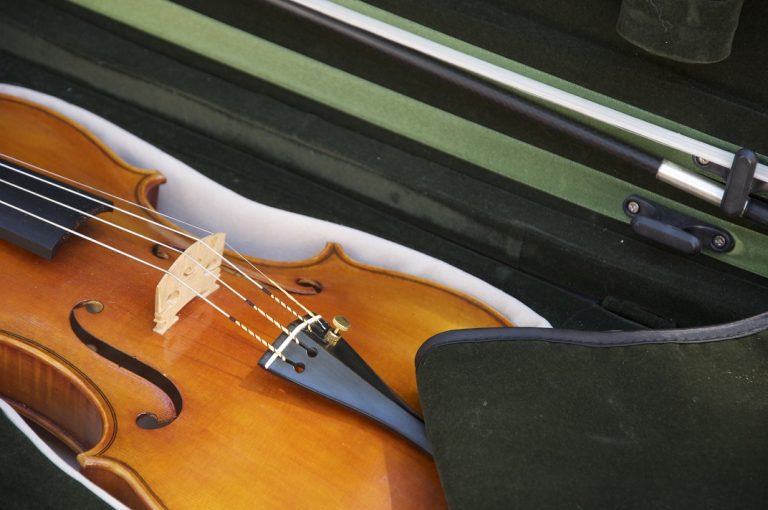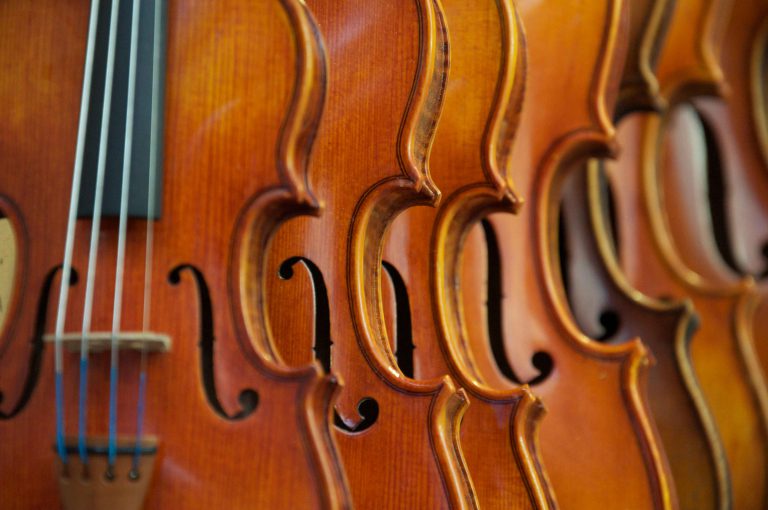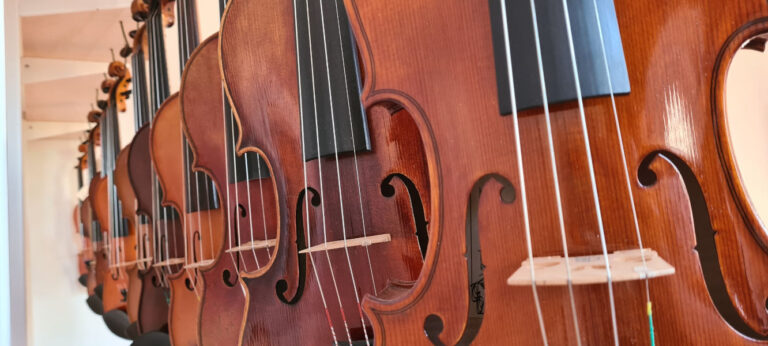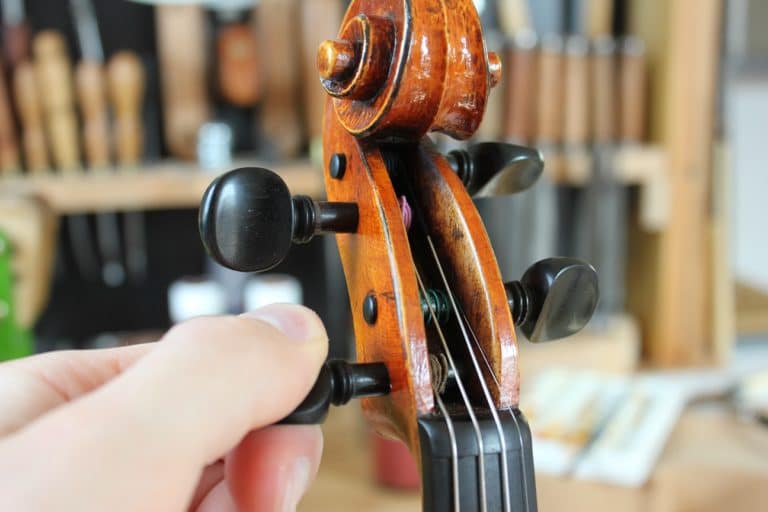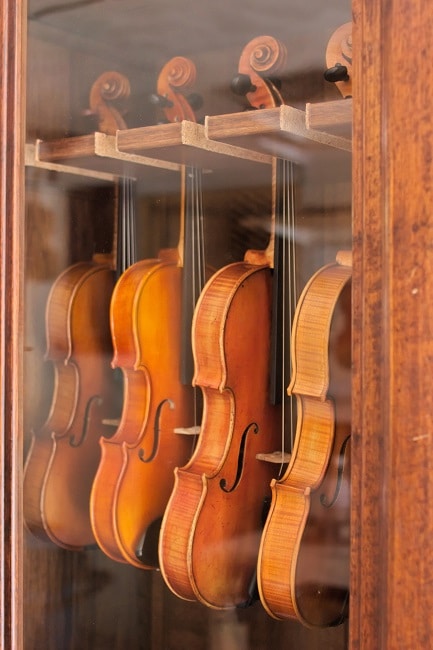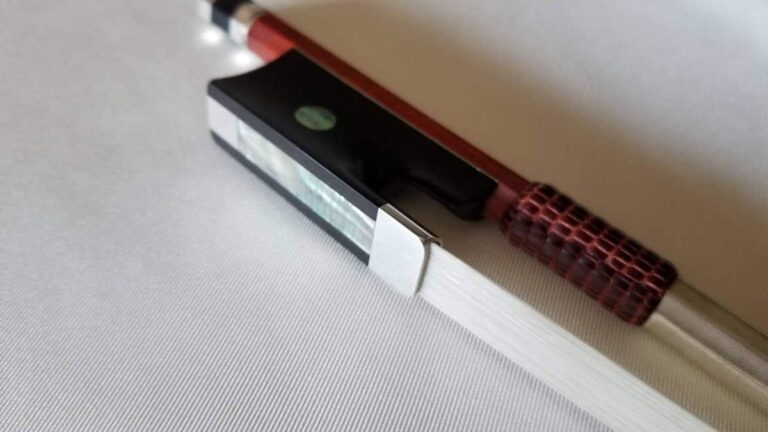Whether you are a beginner or a professional player, it’s easy to get lost among the wide variety of strings available. Moreover, each string is a unique combination of complex cores, windings and technological innovations. There are so many choices it does not help to find the right string for your violin, viola, or cello. That’s why this page is here to guide you choose your violin strings.

Choose your violin strings
Just like every musical tool, there’s not one good tone colour. Which means your personal experience will always have an important say on your choice of strings, whether it fits your instrument and your ears. However, talking to other musicians or violin makers about their own experiences can be very useful. Here are different criteria to help your choose your strings:
- There’s no sound without strings. You can have the best instrument ever, if the quality of the strings is poor, you’re not getting anywhere. On the contrary, good strings will improve significantly even the worst instruments’ performances.
- Without surprise, the price gives you a good idea of the result you can have. However, your level or your instrument may not need extremely expensive strings. It would be a shame to buy some and not be able to make the most of them.
- If you can, do not hesitate to try out different sets and tension settings. Besides, it can take a few weeks to realise if the set you’ve fitted on your violin suits you. Indeed, once the strings are stabilised, you can have a precise idea of their acoustic potential.
What to look for in a string
Different parts of the string play a key role in the tone colour and comfort of use. Among them:
- The core lies at the centre of the string. It is the main part and can be made of gut-, steel-, or synthetic-core.
- The winding are wire strands wound around the core on the lowest strings.
- Then, the gauge is another name for the diameter of your string affects a lot of settings, especially your touch.
- And the tension refers to how much pressure the string applies on the instrument.
The core of a string
Gut-core strings
These strings go back to antiquity, maybe even before. Typically made from sheep intestines, gut strings are lower tension than synthetic or steel cores. They’re popular among musicians due to their complex sound rich with overtones.
Because of the low tension and winding method, they are more pliable under the fingers than other strings. However, they tend to have slower response, and require players to be more precise with their bowing. Since they’re made of a living material, gut-core strings are also very sensitive to changes of temperature or humidity, so they need more frequent tuning.
Steel-core strings
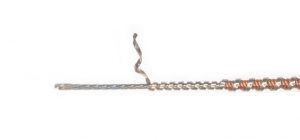
At the beginning of the 20th century, the steel E string paved the way for steel-cores. Their windings were various, though most of the time in chrome steel. Thanks to their quick response and clear, precise and bright tone, they quickly became very popular, to the point that even cello players tried them. However, they suffer from a lack of depth and tonal complexity.
There are three types of steel E string: plain steel (the first one), plated steel, and wrapped steel. Only recently have materials such as tin, gold, or platinum started to be used for E strings.
- The gold-plated E has clear, pure sound but is quickly worn out. If the gold layer goes off, and the string whistles in a very recognizable way.
- The wrapped E displays less brightness and sharpness. The sound is smoother and warmer but the response slower. If your E tends to whistle, they’re a good choice for you.
Synthetic core strings
At the middle of the 20th century, Austrian string maker Thomastik-Infeld introduced his new strings with a perlon-core (a type of nylon): the Dominant. They were instantly successful, and revolutionised modern violin making. The aim of a synthetic-core is to be a more stable version of a gut-core. Though less rich and more focused, the Dominant’s tone and touch are very similar to their natural counterpart, except the Dominant doesn’t get out of tune.
To overcome the tone issues, new synthetic-cores have arisen more recently. And although they still do not sound as fine gut-cores, these synthetic-cores made with very advanced technology offer interesting and sophisticated sound characteristics.
To sum up the core of the string
[columns] [span4]
Gut
[icon color=”#81d742″ icon=”kt-icon-plus-circle” size=”25px”]
- Rich overtone and depth
- Pliable under the fingers
[icon color=”#dd3333″ icon=”kt-icon-minus-circle” size=”25px”]
- Very sensitive to temperature and humidity changes
- Expensive
[/span4][span4]
Steel
[icon color=”#81d742″ icon=”kt-icon-plus-circle” size=”25px”]
- Lasts a very long time
- Cheap
- Not affected by temperature and humidity changes
[icon color=”#dd3333″ icon=”kt-icon-minus-circle” size=”25px”]
- The sound lacks warmth and richness
[/span4][span4]
Synthetic
[icon color=”#81d742″ icon=”kt-icon-plus-circle” size=”25px”]
- The quality of tone is worth the money
- Not affected by temperature and humidity changes
[icon color=”#dd3333″ icon=”kt-icon-minus-circle” size=”25px”]
- Can take time to stabilise after being fitted
[/span4][/columns]
String’s gauge
Even if they are closely tied to one another, the string’s tension and gauge are two very different things. Let’s take unwound gut strings: when a gut core is tuned at the same pitch than a steel core or synthetic core, the gut one will still be thicker (wider gauge) than the others, though its tension will be lower. Hence the need of widening the notches of the bridge and the nut when restringing the instrument.
To put it simply, when buying strings, each model has three gauges. But why? Here are their main differences. Though not as powerful as a medium gauge of the same set, a thin (also known as light, weich, or dolce) string will have a lower tension and brighter sound. The opposite is true for thick (or heavy, stark or forte) strings – a darker tone, but less sensitive to the grip.
String’s tension
Tension is often confused with gauge. As I’ve already explained, they are linked, but different: indeed, tension is the pressure applied on an instrument. It affects directly the sound.
Even the least expensive strings are come out in different tensions: light, medium, and heavy. It’s easy to feel the lower tension when you play on your instrument: it’s when strings are easier to press down on the fingerboard.
- Gut-core tension is way lower than that of the other types
- Synthetic-core tension is higher than that of the gut-core
- Steel-core tensions are way higher than that of all the other types
When trying out new strings, you’d better begin with medium gauge and tension strings. You can adjust them afterward according to what you want. Be careful, in some cases, too much tension can muffle the sound.
String winding
It’s the process of wounding a material, most of the time metallic, around the core. This was originally used to decrease the wide diameters of the lower gut-strings. Nowadays, there are several metals and composites used in winding. Tungsten, for example, helps to control the grip and the tension. This way, a high-tension string can be thinner than one made of less dense metal such as aluminium or silver.
Some materials can also be used because of their physical and chemical properties. For instance, some players with very acid perspiration can have their aluminium winding corroded very quickly. On the contrary, silver or steel wrapping could avoid that incident.

Finding the right strings to your needs
Each violin, viola, cello or double bass has its own tonal characteristics. Sure, a violin maker can improve or change them. However, it is possible to adjust the sound or the balance of your instrument by yourself – you have to choose carefully the strings of your violin, viola, or bass.
You may ask yourself a few question before choosing the strings and try them out: what are the tonal characteristics of my instrument? What strings do I use? What sound do I want to hear? Once you’ve answered these questions, you will be ready to follow my lead to find the sound you’re looking for.
The tone is too high
If your instrument is too bright, you can try a darker, warmer string. Synthetic cores like Pirastro’s Obligato or Aricore, Thomastick’s Infeld Red or Vision Solo might be a good idea. If you like gut-cores, you may want Pirastro’s Eudoxa. Besides, Pirastro’s synthetic-core Evah Pirazzi are very popular. Despite being brighter than other dark strings, their warmth keeps them well balanced.
And if your instrument really screeches at your ear, a lower tension string such as Larsen’s Tzigane will help tone down these unpleasant sounds.
The sound is not precise enough
If your instrument is too dark, a bright set of strings can enhance it. Take for example Thomastik‘s Vision, Infeld Blue, or Dominant; or Pirastro’s Tonica or Wondertone. If you like gut-strings better, Pirastro’s Passione solo or Olive will be just great. As for steel-core, D’Addario’s Helicore are good strings for a small budget.
My instrument is dull
If your instrument has a flat or unclear sound, light-tensions of the bright strings can help focus the sound and make it more expressive. Musicians are often looking for more volume (sometimes less), but assessing the volume difference between strings is very difficult. Brighter and more precise tones usually sound louder. They may also project better.
Your music style
Classical musicians usually go for gut or synthetic strings. However, for other styles, such as jazz or folk, steel strings are the best. Same goes if your instrument is amplified: your strings do not need to have the quality that would be required for pure acoustic sessions. On the contrary, if you are a baroque player, gut cores are the closest you can get from the strings used at that time.
Precious tips to choose your violin strings
In my store, you can find a lot of string sets, as well as information, advice, and reviews. Feel free to click on the model to have access to precise content about the string that interests you.
[carousel type=”cat-products” columns=”3″ items=”8″ speed=”9000″ scroll=”all” cat=”strings”]
Should you mix your strings?
The instrument of your dreams is perfectly balanced, with no string higher or lower than the others. Sadly, real instruments do not work this way. Hence a lot of musicians mix various sets of strings to reach the best sound possible.
Even if you can mix your strings any way you like, full sets are made to provide the best balance possible. However most violin and viola players keep the three lower strings and use one from another set for the first string. For instance, a standard setup can be a Dominant set without the E string that isn’t very popular.
In any case, trying things out is the only way to find the best balance possible.
Find the balance between setup and restring
Choosing the right string for your violin will not solve all your instrument’s problems. If your violin, viola, or cello is unbalanced, you’d better have it adjusted by a violin maker before anything else. It is possible to make a difference just by moving the soundpost.
To solve the balance problems by changing the strings, a good start would be to change the gauge and the tension. This will help the instrument sound like you want. For instance, Thomastik’s Infeld Red (dark) and Blue (bright) strings are made to be mixed in order to find a proper balance. Be careful though: mixing different types and brands of strings can lead to differences in tension and calibre. This might be bad for the other strings. There’s also the issue of not having the same thickness in the strings.

Choose your violin strings based on their lifetime
The price of high-quality strings can be dissuasive. That’s why you should always wonder how long the strings are going to last before changing them. Here a different factors that can affect the string’s lifetime:
- Their materials: if are they affected by perspiration or their surroundings.
- How they are used: your technique or how you play can be tough for the strings.
- How acid your perspiration is.
- If you clean your strings after practice.
Depending on these factors, strings may last between a few weeks to a few months. Please keep in mind that even while resting in the case, a string under pressure stretches gradually and loses its qualities. Thus when you get back to your instrument, you need to restring it in order to restore its tone colour.
[columns] [span3]
Professional
A serious professional musician will change their strings when they notice a decrease of their performances. Usually this happens after a few weeks or months. However, they may also need a restring before auditions or contests in order to offer the best sound to the jury’s verdict.
[/span3][span3]
Amateur
An amateur musician changes their strings whenever they want or can. Once a year is probably a good frequency.
[/span3][span3]
Student
For a student, school start is the best time to change their strings. However, they can do so for auditions or exams rehearsing as well.
[/span3][span3]
Beginner
A full check up when school starts is always a good idea when you’re a beginner. This way, the strings can be changed too.
[/span3][/columns]
[blog_posts items=”1″ orderby=”date” ids=”5569″]
What’s the best string?
All in all, choosing strings can be a long and painstaking process. At this point, you may wonder if the best string actually exists. A string that would solve all our problems, for musicians as for violin makers. If such a string existed, life would be much simpler! Nevertheless, just like the perfect violin, viola, or cello doesn’t exist, each string in itself can be taken as a key. Thanks to this key, you can unlock the potential of your instrument – however, no matter how hard you try, forcing this safe without the right tools is just impossible.
That is why I shared my experience with you. I hope these explanations will support you on the challenge of choosing the strings for your violin, viola, or cello.
Come and choose your violin strings at my workshop
Showing is often much more telling than words. If you’re still at a loss regarding which strings would unfold at best your instrument’s potential, you can contact me. Not only can I give you more precise advice on what you’re looking for, but I can have you try the different sets available at my store. Do not hesitate to take an appointment for a trial session!

